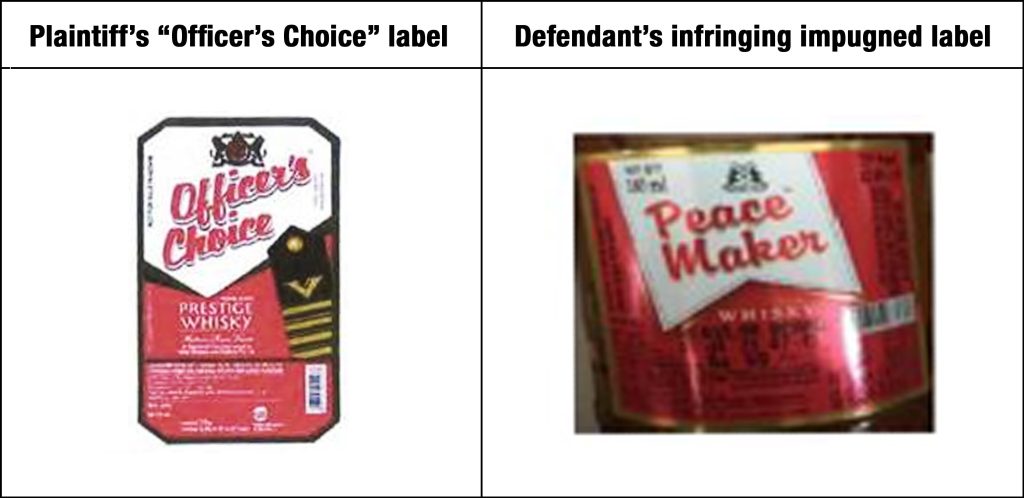CS(COMM) 274/2021
ALLIED BLENDERS AND DISTILLERS (P) LTD. v. HERMES DISTILLERY (P) LTD.
Decided on 15 January 2024| HIGH COURT OF DELHI
Facts
Allied Blenders, a liquor manufacturer, has owned the registered trademark for Officer’s Choice Prestige Whisky since 2013. The company brought a case against Hermes Distillery Private Limited for allegedly infringing its trademark with the latter’s Peace Maker Prestige Whisky label, which had been introduced in 2019. Allied Blenders claimed that Hermes’ label bore significant similarities to its own, including font style and colour, positioning of brand names, product description, mark placement, colour scheme, border design, and central design element. The plaintif filed suit under Sections 134 and 135 of the Trade Marks Act, 1999 seeking an injunction against the defendant.
A comparison table of the two labels is set out below:

Arguments before the court
The defendant argued the Officer’s Choice marks had been inconsistent over time and that red and white colour combinations were common in the trade. According to the defendant, several other manufacturers used a similar combination of colours for their products. Since none of the claimed features were distinctive, there was no case of infringement or passing off.
Additionally, the defendant claimed that the court lacked territorial jurisdiction. The defendant had not sold the product under the Peace Maker mark in Delhi, nor had it acquired a license for its sale there. The defendant had been selling the whisky in Haryana, Assam and North Karnataka So there was no real or imminent threat to the plaintiff’s trademark and trade dress under Officer’s Choice in Delhi. The defendant also argued that the present case was not a trademark issue, but concerned a label with a colour combination, and there can be no exclusivity for a colour combination.
The plaintiff said that that defendant’s Peace Maker label imitated the distinctive features of its Officer’s Choice label, including the colour combination and layout, which infringed its statutory and common law rights. Such imitation could lead to consumer confusion and dilution of the plaintiff’s brand equity.
Judgement
The Delhi High Court issued an interim injunction against Hermes Distillery, prohibiting the sale of whisky under the Peace Maker label. Though the word marks on the labels were different, the court stated that the similarity in the labels was obvious. The court found that the similarity of insignia, the arrangement of colours for the background and lettering and the use of a golden border, gave rise to a similarity of the labels, which would confuse consumers in dimly lit bars and stores. Therefore, the court granted an injunction in favour of the plaintiff while permitting the defendant to exhaust its stock in 30 days.
The court highlighted the concept of “smart copying” and ruled that the similarities were too significant to ignore. The court dismissed Hermes’ jurisdiction argument by observing that the defendant’s trademark application was submitted by a director residing in Delhi, and the defendant conducted business in Delhi and had a warehouse in the city. The court also suggested that any jurisdictional concerns could be addressed at a later stage if necessary.
The court reiterated the importance of the overall visual impression created by a label in determining trademark infringement and passing off, dismissing the defendant’s contention that changes in its trade dress were sufficient to differentiate its product from that of the plaintiff. The assessment of trademark infringement hinges on similarity rather than identity, judged from the perspective of an average consumer with imperfect recollection.
Analysis
By granting an injunction against the use of the Peace Maker labels by Hermes Distillery, the Delhi High Court affirmed the significance of protecting established trademarks against imitations that could mislead consumers. This case underscores the nuanced approach courts must take in evaluating claims of trademark infringement and passing off, where the essence of the alleged infringement lies in the likelihood of confusion among the public, rather than in the exact replication of trademarks or trade dress. The court’s reliance on scenarios of dim lighting and assumptions about consumer behaviour underlines the challenge of applying traditional trademark infringement tests to modern market dynamics. This highlights the evolving nature of trademark law as it intersects with consumer experience and market realities, suggesting that future cases may need to balance empirical evidence with the practicalities of consumer perception.
Photo: 34189826 | © BrunoWeltmann | Dreamstime.com
